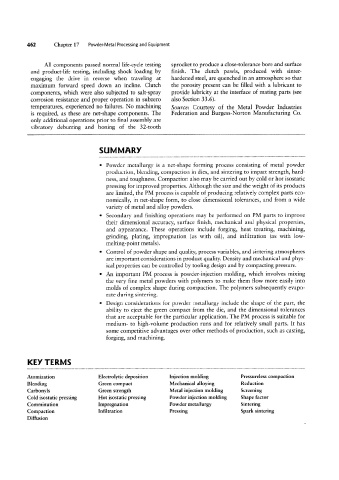Page 482 - 04. Subyek Engineering Materials - Manufacturing, Engineering and Technology SI 6th Edition - Serope Kalpakjian, Stephen Schmid (2009)
P. 482
462 Chapter 17 Powder-Metal Processing and Equipment
All components passed normal life-cycle testing sprocket to produce a close-tolerance bore and surface
and product-life testing, including shock loading by finish. The clutch pawls, produced with sinter-
engaging the drive in reverse when traveling at hardened steel, are quenched in an atmosphere so that
maximum forward speed down an incline. Clutch the porosity present can be filled with a lubricant to
components, which were also subjected to salt-spray provide lubricity at the interface of mating parts (see
corrosion resistance and proper operation in subzero also Section 33.6).
temperatures, experienced no failures. No machining Source: Courtesy of the Metal Powder Industries
is required, as these are net-shape components. The Federation and Burgess-Norton Manufacturing Co.
only additional operations prior to final assembly are
vibratory deburring and honing of the 32-tooth
SUMMARY
Powder metallurgy is a net-shape forming process consisting of metal powder
production, blending, compaction in dies, and sintering to impart strength, hard-
ness, and toughness. Compaction also may be carried out by cold or hot isostatic
pressing for improved properties. Although the size and the weight of its products
are limited, the PM process is capable of producing relatively complex parts eco-
nomically, in net-shape form, to close dimensional tolerances, and from a wide
variety of metal and alloy powders.
Secondary and finishing operations may be performed on PM parts to improve
their dimensional accuracy, surface finish, mechanical and physical properties,
and appearance. These operations include forging, heat treating, machining,
grinding, plating, impregnation (as with oil), and infiltration (as with low-
melting-point metals).
Control of powder shape and quality, process variables, and sintering atmospheres
are important considerations in product quality. Density and mechanical and phys-
ical properties can be controlled by tooling design and by compacting pressure.
An important PM process is powder-injection molding, which involves mixing
the very fine metal powders with polymers to make them flow more easily into
molds of complex shape during compaction. The polymers subsequently evapo-
rate during sintering.
Design considerations for powder metallurgy include the shape of the part, the
ability to eject the green compact from the die, and the dimensional tolerances
that are acceptable for the particular application. The PM process is suitable for
medium- to high-volume production runs and for relatively small parts. It has
some competitive advantages over other methods of production, such as casting,
forging, and machining.
KEY TERMS
Atomization Electrolytic deposition Injection molding Pressureless compaction
Blending Green compact Mechanical alloying Reduction
Carbonyls Green strength Metal injection molding Screening
Cold isostatic pressing Hot isostatic pressing Powder injection molding Shape factor
Comminution Impregnation Powder metallurgy Sintering
Compaction Infiltration Pressing Spark sintering
Diffusion

